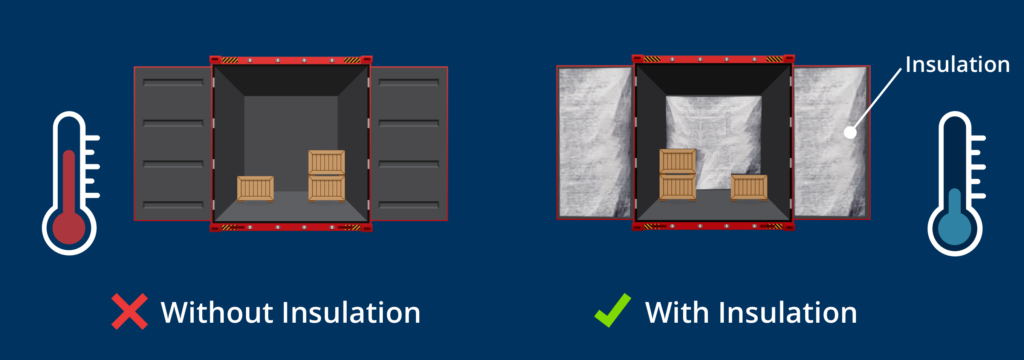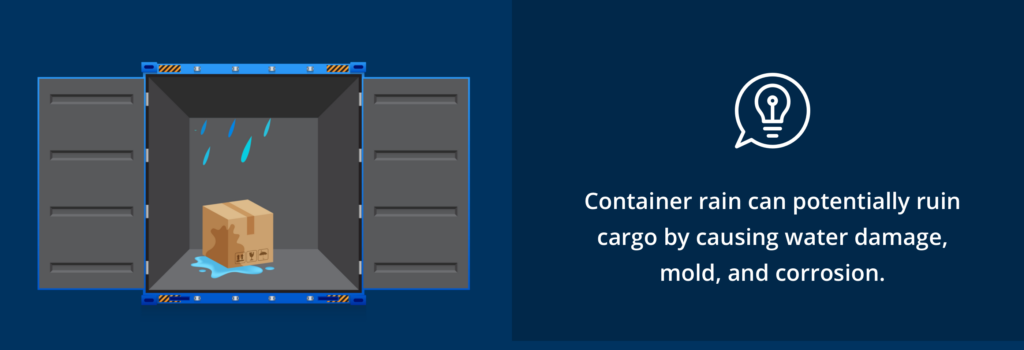4 Ways to Cool Down a Shipping Container

Steel shipping containers are commonly used by importers and exporters to ship cargo from one place to another. Whether items need to be transported across the country or around the world, goods are often placed in shipping containers and stacked on cargo ships, trains, or commercial trucks, which take the items to their destination.
All sorts of items are transported in shipping containers, from perishable food and beverage shipments to chemicals and pharmaceuticals. Some of these items are more sensitive than others, and must remain in a carefully controlled climate while in transit to prevent them from spoiling or becoming damaged. Goods like fresh fruits and vegetables, electronics, paints, and adhesives are just a few of the many items that are susceptible to irreparable damage when exposed to extreme temperatures, especially uncontrolled heat.
When exposed to sunlight and high temperatures, the insides of steel shipping containers can reach very high temperatures. And, as stated above, these extreme temperatures can negatively impact cargo stored inside shipping containers. So how do you maintain a steady climate inside shipping containers and keep your cargo safe while in transit? In this article, we’ll share some important tips on how to cool down a shipping container.
- Install Insulation
Much like we insulate our home to prevent unwanted heat or cold from seeping in, insulating a shipping container can help the inside maintain a steady temperature. Effective insulation can mitigate the effects of extreme external temperatures, and prevent the inside of the shipping container from getting so hot that it damages the cargo. Additionally, shipping container insulation provides other benefits, such as preventing goods from suffering moisture damage.

When it comes to shipping container insulation, Eurolog Packing Group has a variety of options to choose from. Our line of Temcore products utilize innovative technology to prevent cargo from being damaged due to excessive heat or humidity. Choose from our Temcore Blanket, Temcore Liner, and Temcore Cover, each of which is designed to minimize the negative effects of extreme external temperatures on shipping container cargo.
2. Add Ventilation
Ventilation windows or slits can provide sufficient airflow inside shipping containers, which can both keep the interior cool and prevent excess moisture from building up. Consider adding a vent or two at each end of the shipping container to set up a cross-ventilation system that can serve as a natural form of climate control.
Introducing shipping container vents can be a simple and economic way to keep the insides of the containers cool. However, make sure to keep the vents relatively small or attach a grate so that insects, birds, and rodents aren’t able to enter the shipping container.
3. Coat the Container with Reflective White Paint

If you’re wondering how to cool down a shipping container in a way that’s both easy and cost-effective, look no further than white paint. Standard steel shipping containers often come in colors such as blue, red, brown, green, and so on. However, darker colors absorb more light, and this, in turn, becomes converted to heat. The result is that, when painted in darker colors, shipping containers can absorb light from the sun and quickly heat up inside.
On the other hand, lighter colors are better at reflecting light. Colors such as white and even light grey are more efficient than darker colors when it comes to reflecting sunlight. Thus, by painting the roof of a shipping container—the place where it’s most often and directly hit with sunlight—white, you can produce a natural cooling effect in the interior of the container.
4. Dehumidify the Space
When the interior of a shipping container heats up, moisture trapped inside can evaporate and rise to the top of the container. Then, when it cools, this moisture can drip down onto the cargo and seep into goods stored within the shipping container. This is a problem commonly referred to as “container rain” and it can potentially ruin cargo by causing water damage, mold, and corrosion.

By taking steps to dehumidify your shipping containers, you can protect your cargo from the negative impact of extreme temperature changes. At Eurolog Shipping Group, we offer an array of desiccant bags, absorbent pads, thermal liners, and absorbent blankets that can keep your cargo safe from moisture damage. Ensure the safety of your cargo and mitigate the effects of extreme temperature changes by putting these dehumidifying products to use in a shipping container.
If you’re in the business of transporting goods, you want to make sure that they stay safe while in transit. Losing cargo to uncontrolled heat is an unnecessary loss of both material goods and potential profit. Eurolog Shipping Group can keep your cargo safe by providing cutting edge climate and moisture control solutions. Contact us today to learn more about how to cool down a shipping container using our top-quality products.

Sandra Malouf is the President of Eurolog Packing Group and has spent her career focused on Industrial Packaging. With a proven track record of helping businesses avoid supply chain disruptions, Sandra’s visionary leadership elevates the industry. She’s committed to developing sustainable practices and continues to shape the future of industrial packaging by listening to the customer and offering unique solutions applicable to various industries across the world. The company’s main focus is temperature stabilization and moisture damage prevention in exports affected by extreme variations in global temperatures.
© 2024 Eurolog Packing Group








